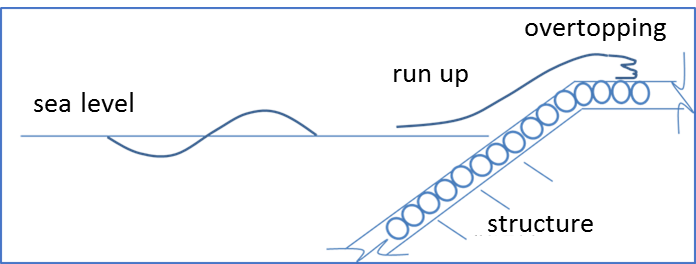In general, the methods for obtaining designed wave conditions are measured records analysis, empirical formula estimation and numerical simulation. The suitability of practical applications is as follows:
-
Measured records analysis
Long-term observation data of wave is generally obtained by data buoy in Taiwan. It is also the basis of design wave conditions for deep sea waves. However, the existing wave recording and the monitoring time is short, mostly less than 20 years. Direct reference as a wave design condition carries uncertainty.
In addition, due to the different characteristics of the near-shore bathymetry, the deep sea waves are affected by the complexities like refraction, diffraction, reflection and waves breaks due to the depth of the bathymetry and the influence of the structure. If the data buoy is far from the coastal protector, a considerable error will result if the incident significant wave height at the toe is cited. Therefore, the actual measurement records of data buoy are only verified the results of the wave field numerical simulation at this stage.
-
Empirical formula estimation
American scholars Sverdrup and Munk (1947) established the quantitative relationship between wave height, cycle and sea surface wind speed and blowing distance, which is the SM wave ; then, there are successive SMB method, SPM method, JONSWAP method, and spectral wave method.
However, these calculation methods are mainly prevalent in the period when the early computer has not yet developed, and some are based on the walrus records in a specific area to estimate wave parameters. If it is to be applied to all coastal of Taiwan, the characteristics of some regions are different. There is a deviation and the poor accuracy.
-
Numerical simulation
The current wave forecasting models commonly is used including the NWW3 model developed by NOAA, the SWAN model developed by Delft, and the Spectrav Waves (SW) model of MIKE21 developed by the Danish Hydraulic Institute (DHI).
In addition, the above three methods are used to obtain deep sea wave design conditions. Because the waves are transmitted from outer sea to near-shore, they are affected by the bathymetry and the ground objects, causing refraction, diffraction, reflection and wave braking. Therefore, the design significant wave height at the toe conditions are still further calculations required. In general, the wave height of the wave transfer process can be reflected by a simple formula that multiplies the refraction, diffraction, and shallowing coefficient by the water depth variation.
In addition, in terms of the wave braking, it includes nonlinear energy exchange and complex mechanisms such as mixing of air and water. The design conditions can be easily calculated. The empirical formula most commonly used in Taiwan is Goda (1975). The wave height of breaking point and the distance of the breaking point is negatively exponentially decreasing. Numerical model can also be used to calculate the two-dimensional wave field distribution. Common governing equations include Mild-slope eq., Boussinesq eq. and Spectral Waves.
-
Description of suitability
Both empirical formula and numerical simulations have their advantages and disadvantages. The former can be quickly quoted but cannot reflect the influence of rugged terrain. Based on conservative considerations, the design gives more safety factors and covers uncertainty. The latter spent more time due to large calculations, but it can be used to estimate the wave field distribution within the complete range. Those who have obtained the conditions of the various shores of interest (Figure 1) take appropriate measures to respond appropriately. Therefore, in order to avoid excessive design conditions, the wave design can be based on numerical simulation methods, ant to ensure the correctness of the numerical simulation and the actual data to verify.


Figure.1 Run up and over topping of interest shores